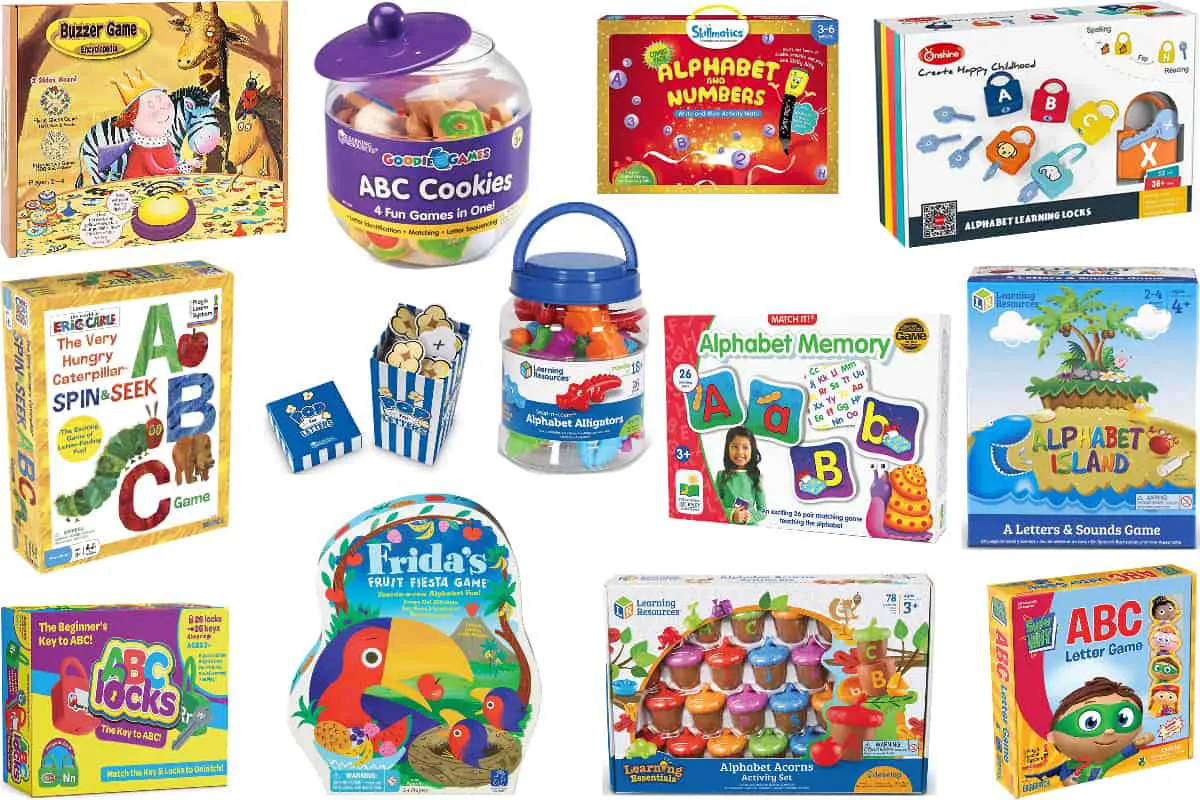This post contains affiliate links.
Children under four years old learn mostly through play – which makes the alphabet games a great tool for them. They help with letter recognition and phonics, which are two essential pre-reading competencies.
The alphabet games in this list fall into 3 categories:
- Board Games, Alphabet Island having the most relevant gameplay
- Board games with cards, Match it! Alphabet Memory being the best for letter recognition
- Toys, Alphabet Acorns & ABC Learning Lock being the most comprehensive
Alphabet Games for Pre-Kindergarten Children
| Game | Type | Age | Players | For | Price | Rating |
| Alphabet Island | Board | 3-5 | 2-4 | Family, School | $$ | ★★★★★ |
| Launch and Learn Alphabet | Board | 3-5 | 2-4 | School, Family | $$$ | ★★★☆☆ |
| Super Why ABC Game | Board | 4-6 | 2-4 | Family | $$ | ★★★☆☆ |
| Frida’s Fruit Fiesta Alphabet Game | Board | 4-5 | 2-4 | Family | $$$ | ★★★☆☆ |
| Alphabet Puzzle Tracing Board Game | Board | 3-5 | 2-3 | Family | $$$ | ★★★☆☆ |
| Answer Buzz Game | Board | 4-5 | 2-4 | Family | $$ | ★★★☆☆ |
| Alphabet Mystery Box | Board | 3-5 | 2-4 | School, Family | $$$ | ★★★☆☆ |
| Alphabet Folder Game Library | File Folder | 4-5 | 2-3 | School | $$$ | ★★★☆☆ |
| Magnetic Alphabet Maze Board | Board | 3-4 | 2-4 | Family | $$$ | ★★☆☆☆ |
| The Very Hungry Caterpillar Spin and Seek ABC Game | Board | 4-5 | 2 | Family | $$ | ★★☆☆☆ |
| Match it! Alphabet Memory | Card | 3-5 | 2-4 | School, Family | $$ | ★★★★☆ |
| Pop for Letters | Card | 3-5 | 2-4 | Family | $$ | ★★★★☆ |
| Goodie Games ABC Cookies | Card | 3-5 | 2-4 | School, Therapy, Family | $$$ | ★★★☆☆ |
| SWAT Game | Card | 3-6 | 2-4 | Family | $$ | ★★★☆☆ |
| Splash ! Jr. Alphabet Game | Card | 3-5 | 2-4 | Family | $$ | ★★★☆☆ |
| Alphabet Acorns | Toy | 3-5 | 2-4 | School, Family | $$$ | ★★★☆☆ |
| Alphabet Dinosaurs | Toy | 3-4 | 1-4 | Family | $$$ | ★★★☆☆ |
| Smart Snacks Alpha Pops | Toy | 3-4 | 2-4 | Family | $$$ | ★★★☆☆ |
| Matching Eggs (Coogam) | Toy | 3-4 | 2-4 | School, Family | $$$ | ★★★☆☆ |
| Matching Eggs (Revvit) | Toy | 3-4 | 2-4 | School, Family | $$$ | ★★★☆☆ |
| Snap-n-Learn Alphabet Alligators | Toy | 3-4 | 2 | Family | $$ | ★★☆☆☆ |
| ABC Learning Lock (Dinhon) | Toy | 3-5 | 2-4 | Family | $$$ | ★★★☆☆ |
| ABC Learning Lock (IQ Toys) | Toy | 3-5 | 2-4 | Family | $$$ | ★★★★☆ |
Pre-K Alphabet games focus on the following abilities (see section “Typical Child Progress”):
- Letter recognition: visually recognize upper and lower case letters by naming them (critical to learn how to read)
- Identification of beginning sounds: identify the sound of the initial letter of a word (also essential for reading)
They can also sometimes be used for:
- CVC word building: create a word made up of a consonant, a vowel, and a consonant (kind of the first pre-reading experience, creating an “aha” moment about the phonetical nature of our language’s encoding system)
- Alphabet sequence or alphabetical order (less important but helpful)
10 Alphabet Board Games for Pre-Kindergarten Children
Alphabet Island (Learning Resources)
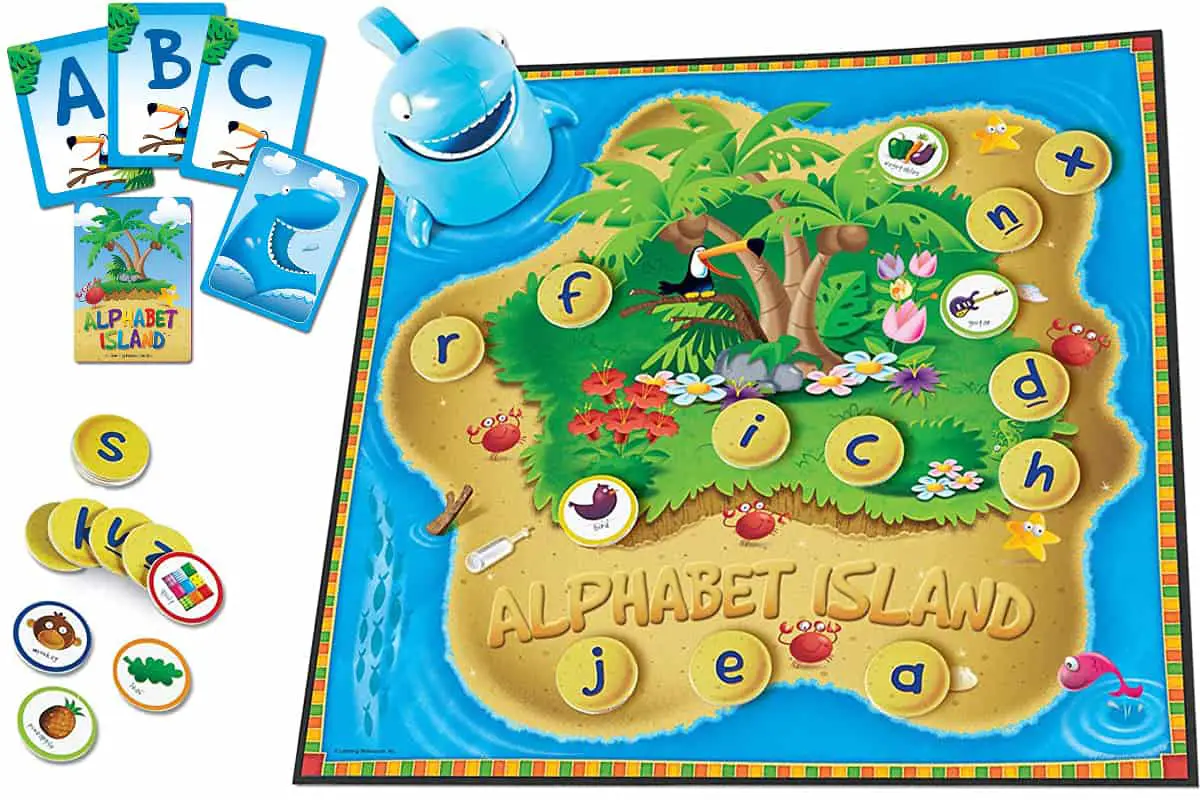
★★★★★
For Families & Schools | Age 3-5 | 2-4 Players
Alphabet Island includes:
includes:
- a game board
- A plastic shark model with a movable mouth
- 28 playing discs (lowercase letters on one side, pictures on the other)
- 26 game cards (uppercase letters on one side, pictures on the other)
It teaches pre-kindergarten children Letter recognition (uppercase and lowercase) and the identification of beginning letter sounds. To win discs, players match the letter discs and cards to either match uppercase letters with lowercase ones, or images with the beginning letter of the word.
The only problem with the rule: Kids feed the shark when they get the shark card. Not a good idea as they indeed love feeding it and most of the time can’t. So I propose instead to feed the shark every time you make a correct match. The game becomes a cooperative game instead of a competitive one, which is much better for learning (and makes it suitable for schools although it is designed for families). The common objective of the players becomes to feed the shark!
Launch and Learn Alphabet (Lakeshore Learning)
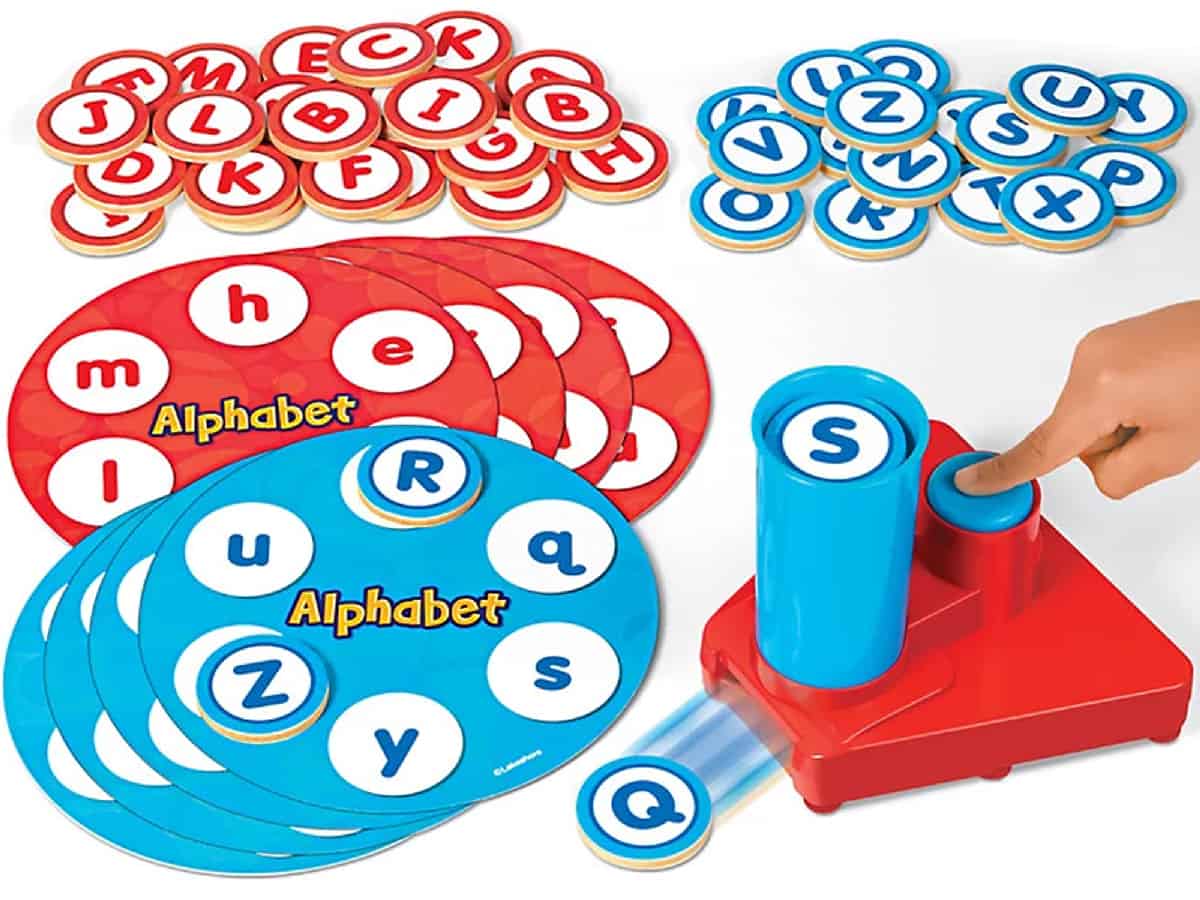
★★★☆☆
For Teachers and Families | Age 3-5 | 2-4 Players
Launch and Learn Alphabet includes a sturdy tile dispenser, 48 wooden tiles and 8 different double-sided game mats.
includes a sturdy tile dispenser, 48 wooden tiles and 8 different double-sided game mats.
I recommend this game to 3–6-year-old children because it helps them practice matching uppercase letters on the tiles to the lowercase letters on the game mats.
This can be used in the classroom because:
- 2-4 players can play at once (It is not time-consuming and not competitive)
- The game mats function like Bingo cards that players can enjoy the game repeatedly by switching them after completing the letters.
The downside which turns out to be the fun part of the game is that children enjoy seeing the tiles fly out from the dispenser. This distracts them from learning the alphabet.
ABC Letter Game (Briarpatch)
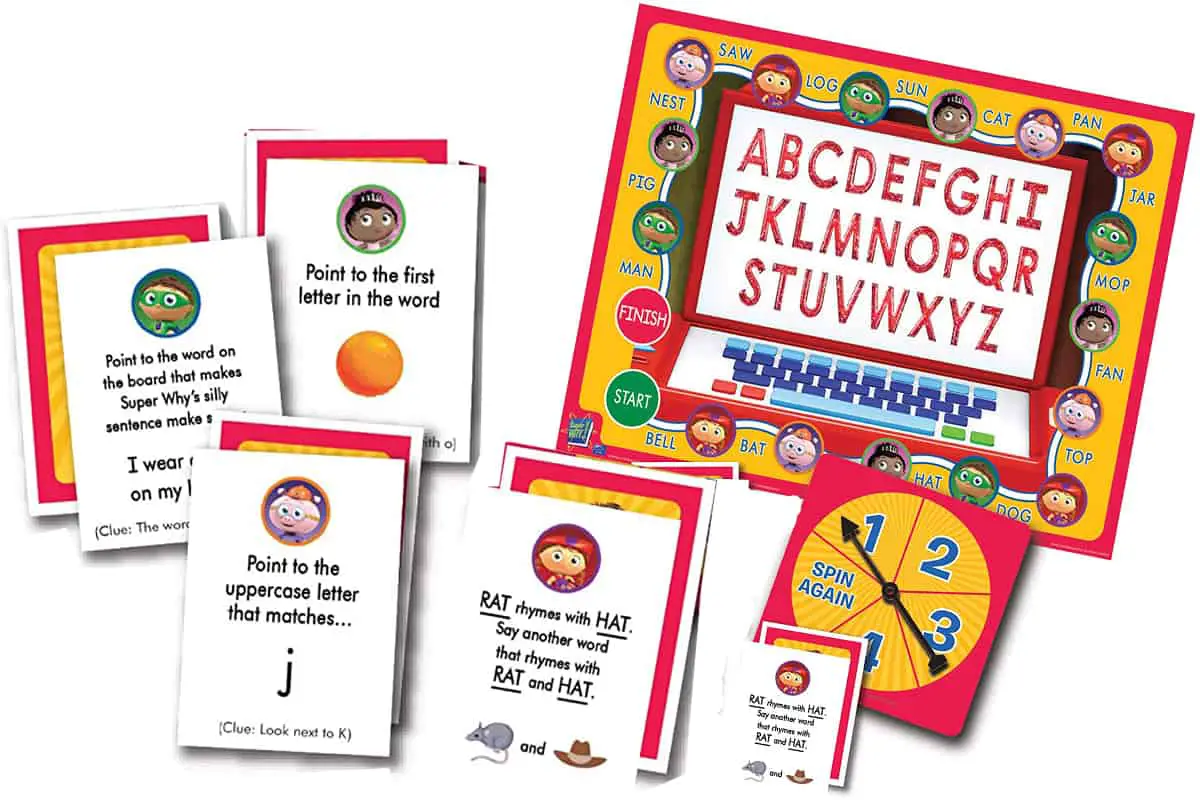
★★★☆☆
For Families | Age 4-6 | 2-4 Players | 30 to 60 minutes
The “Super Why” ABC letter Game includes:
- A game board, a spinner & 4 playing pieces
- 110 question cards
- 4 finger puppets (not required, but children can wear them while playing the game)
The pieces are based on the cartoon characters: Princess Presto, Wonder Red, Alpha Pig, and Whyatt Beanstalk, aka Super Why.
The 110 questions cards are divided into four different learning goals, requiring specific actions from the players:
- Alpha Pig (Alphabet Power) – Players point to the uppercase letter on the board that matches the lowercase letter on the card.
- Wonder Red (Word Power) – Players read the word or look at the picture on a card and give words that rhyme with it (cards ask for two or three words, you might go easy on the timer).
- Princess Presto (Spelling Power) – Players say the word pictured on the card, then point the first letter or the first two letters of that word on the center of the board.
- Super Why (The Power to Read) – players point to the word on the board that:
- Matches the picture on the card, or
- Replaces the underlined word on the card to correct the sentence (The underlined word makes the sentence silly).
Question cards include a clue to encourage young children to participate. An adult is mandatory to read the questions and make sure that the answers are correct. This game is not especially funny but is a good practice for 4 to 5-year-old children for :
- Identifying and matching capital and small letters
- Recalling letter sounds
- Rhyming
- Finding relevant words in a sentence
- Reading basic words
To play ABC Letter Game, players select their moving pieces and place them in the START space. They then take turns:
- Spinning the spinner and moving their piece accordingly (from 1 to 4)
- Picking question cards and keeping them if they answer the question correctly
The player who reaches the finish line with the most cards wins the game.
Frida’s Fruit Fiesta Alphabet Game (Educational Insights)
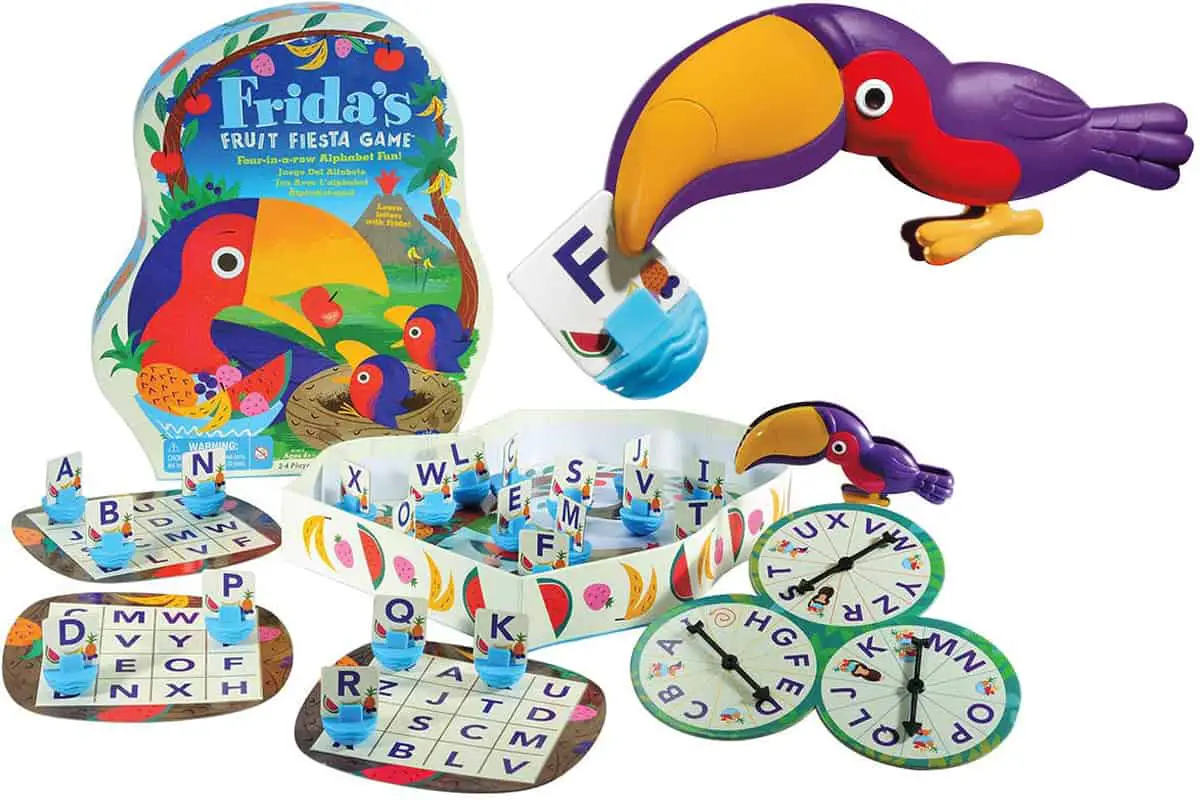
★★★☆☆
For Families | Age 4-5 | 2-4 Players
Frida’s Fruit Fiesta Alphabet Game contains a “Frida Squeezer” (card pincher), 4 nest cards, 1 triple letter spinner, 26 fruit bowls, and a rainforest game board (which doubles as storage).
It helps practice the alphabet, develop fine motor skills and hand-eye coordination.
Players take turns spinning the spinners and making moves. According to where the spinner lands, the player:
- Letter: Uses the “Frida squeezer” to catch the matching letter (placed in a “fruit bowl”), and if possible, places it on their nest card (looks like a bingo card).
- Fruit bowl: Choose any fruit bowl and place it on their card.
- Double fruit bowl: Chooses two fruit bowls.
- Monkey: Loses a turn and returns one fruit bowl to the rainforest.
- Bird: Takes a fruit bowl from an opponent’s card to complete their own card.
The instructions are difficult to explain to pre-kindergarten children, so coaching is necessary. Other drawbacks are:
- It showcases uppercase letters only.
- Stealing letters from other players creates conflicts with young children
- Children get frustrated when they can’t pick up the letter because their grip is weak
- Small children hate losing their turn
On the other hand, this game is not too long. Parents may emphasize picking up the letters in the correct sequence. Ask children to recite the letter first before giving them the signal to pick up the letters.
Toddlers may play this game without using the spinner and the squeezer: simply have them match the fruit bowls with the letters on the nest cards or tell the letter aloud (with help).
Frida’s Fruit Fiesta Alphabet is still lovely with 4–5-year-old children and helps cover the basics of the alphabet.
Answer Buzz Game (Binggoo)
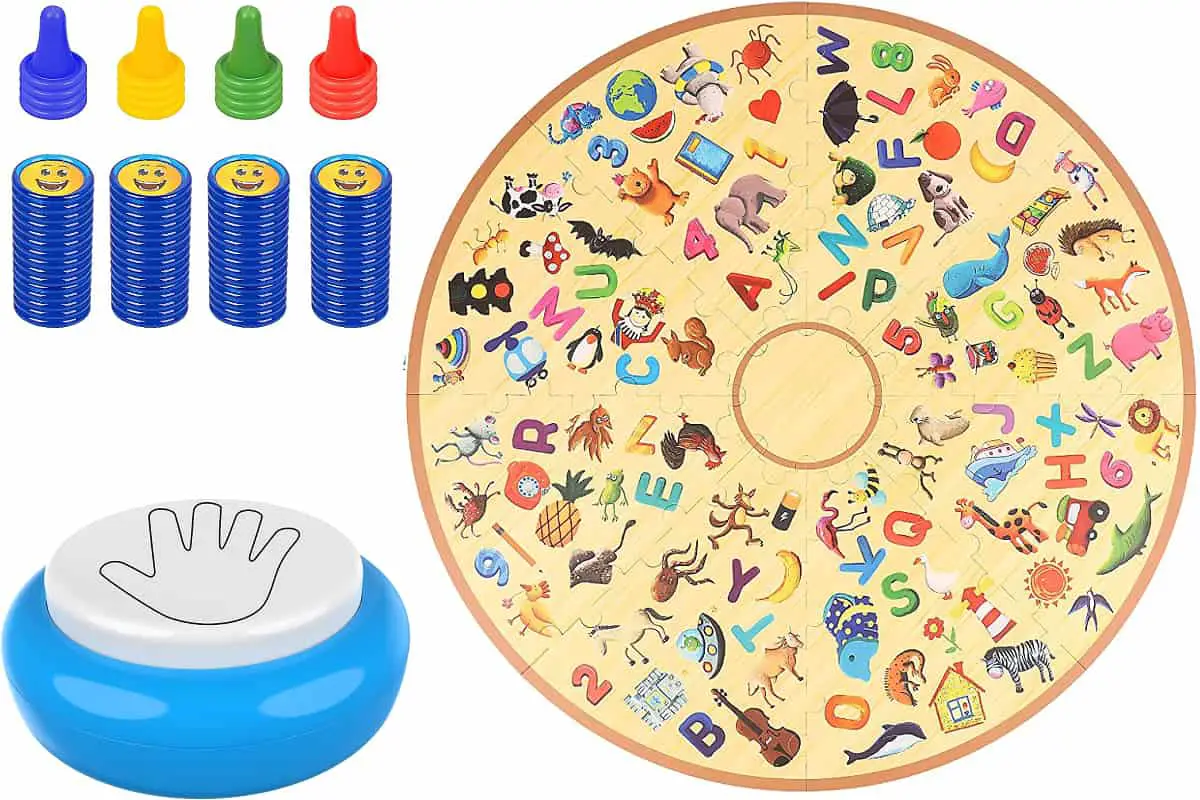
★★★☆☆
For Families | Age 4-5 | 1-4 Players
Answer Buzz Game is an activity board set composed of:
is an activity board set composed of:
- A puzzle board (cardboard)
- A battery-operated speaker
- 60 blue reward coins
- 4 pawns for each color
- 1 dice
There are two ways to play Answer Buzz Game. The Rush to Answer mode includes letter recognition (uppercase letters only):
- Press the buzzer and listen to the question (There are 500 questions)
- Players race to answer the question by putting their pawn on the correct picture on the board (letter, number, animal or object). The buzzer reveals the answer.
- The winner gets a coin.
- The first person to get 30 coins wins the game.
Here is a sample question: “It has tall neck and yellow-brown fur, what animal is that?”
The game can be played autonomously (the buzzer gives the answer) and includes learning letters.
Alphabet Mystery Box (Lakeshore Learning)
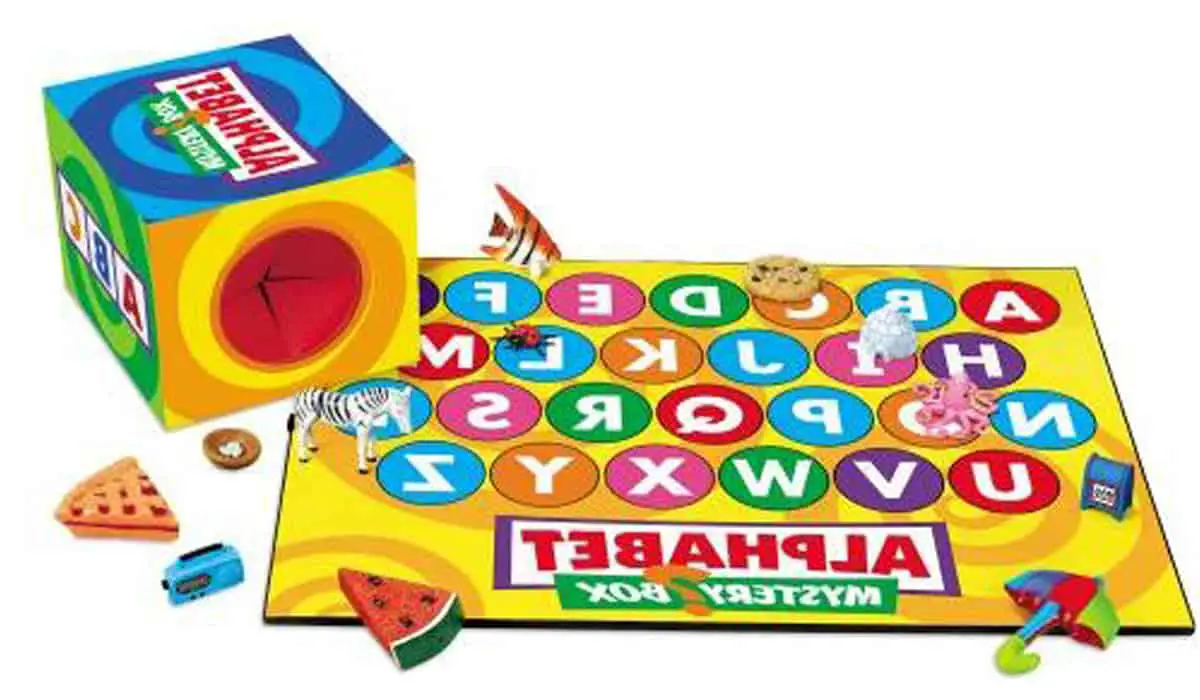
★★★☆☆
For Teachers and Families | Age 3-5 | 2-4 Players
Alphabet Mystery Box includes a game board printed with uppercase letters and a box that contains 26 miniatures. Each miniature corresponds to a letter of the alphabet. Pre-kindergarten children enjoy this game because they love the mystery of pulling out the item from the box and matching it to the letter on the game board.
includes a game board printed with uppercase letters and a box that contains 26 miniatures. Each miniature corresponds to a letter of the alphabet. Pre-kindergarten children enjoy this game because they love the mystery of pulling out the item from the box and matching it to the letter on the game board.
Teachers can make this game more exciting by:
- Asking the child to guess the item while reaching for it inside the box
- Adding more items in the box
Although this game uses uppercase letters only, it helps boost letter recognition and sound association to the alphabet.
Alphabet Folder Game Library (Lakeshore Learning)
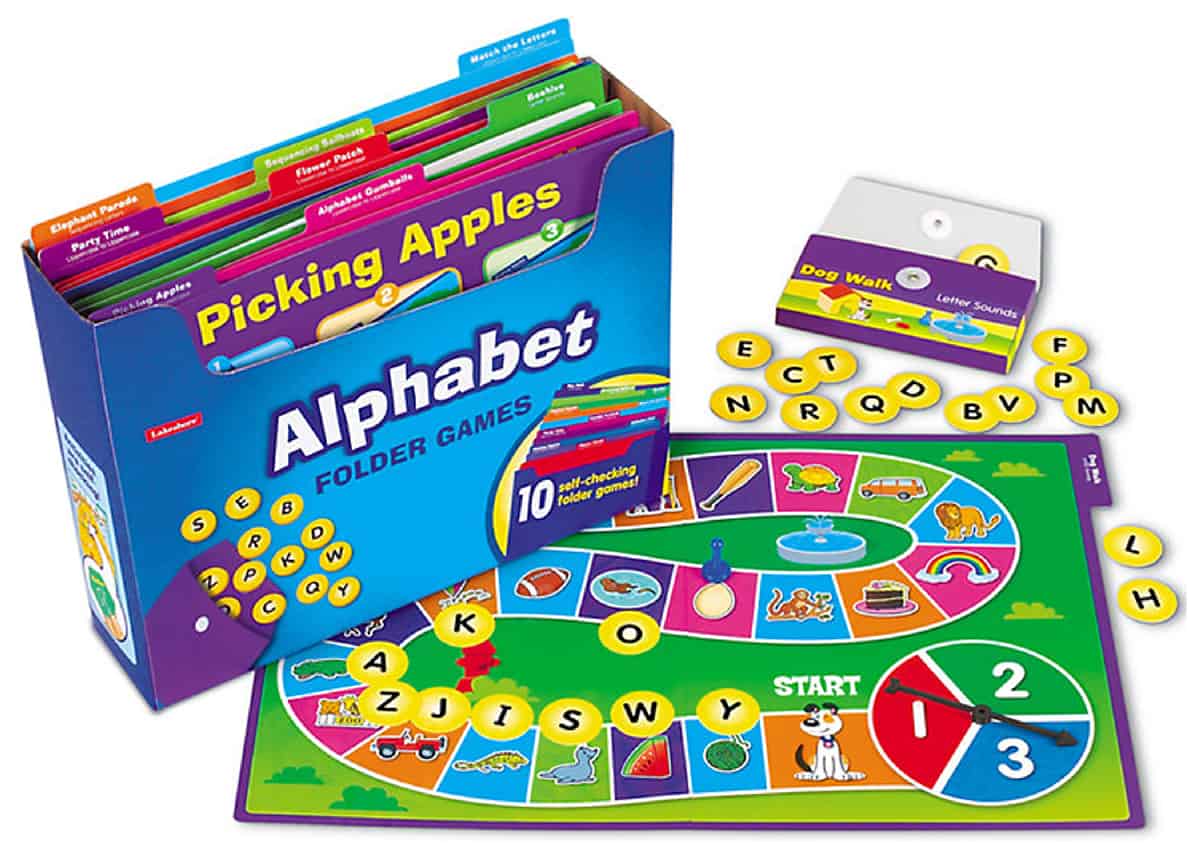
★★★☆☆
For Teachers | Age 4-5 | 2-3 Players
Alphabet Folder Game Library includes a durable storage box that can store 10 folders which measure 9 1 /4” x 11 5/ 8”.
includes a durable storage box that can store 10 folders which measure 9 1 /4” x 11 5/ 8”.
The folders contain self-correcting game pouches that children can play at their own pace. All they have to do is follow the picture instructions. This set features games on alphabet recognition and letter sounds.
Magnetic Alphabet Maze Board (Gamenote)
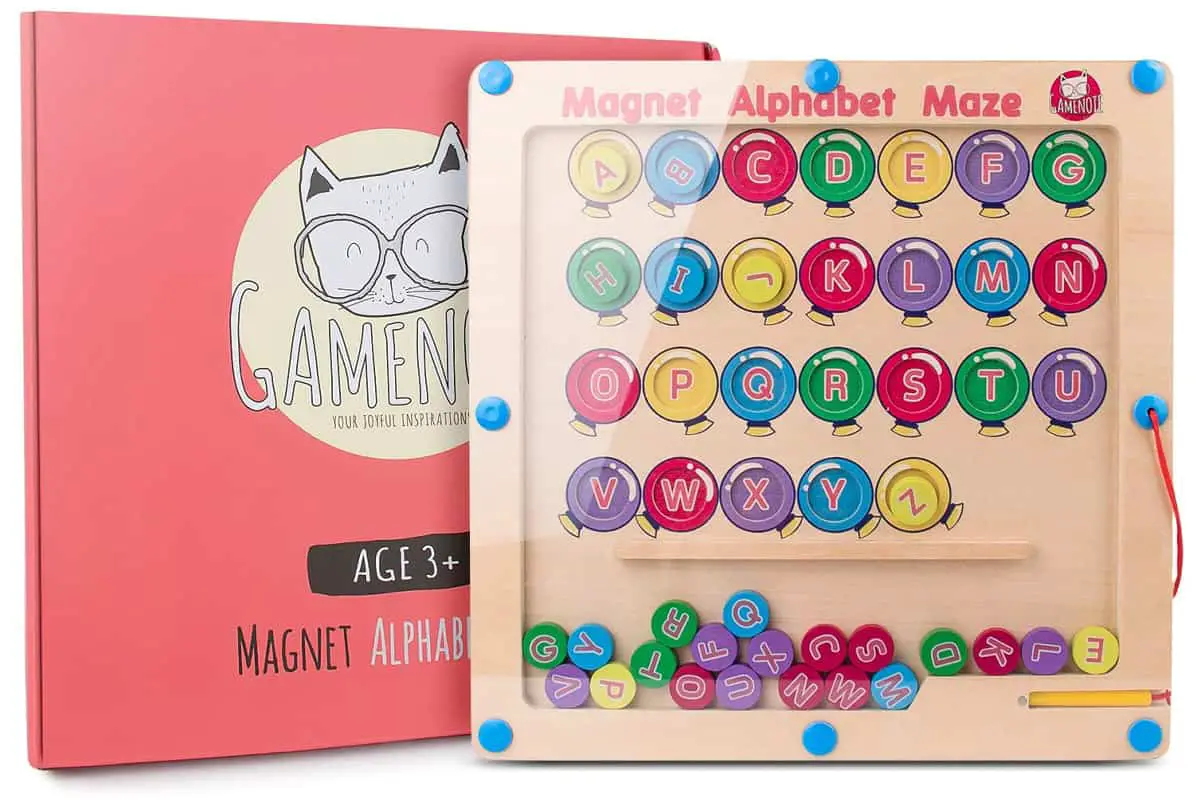
★★☆☆☆
For Families | Age 3-4 | 2-4 Players
Magnetic Alphabet Maze Board is a wooden maze game with a plexiglass top.
is a wooden maze game with a plexiglass top.
The board has 26 slots (painted with balloons that represent alphabet letters) for 26 corresponding letter magnets. A magnetic pen is attached to the board. The game is easy to keep because the puzzle pieces are secured under the plexiglass.
2-4 players can take turns playing this game. Their goal is to match the letter magnet to its corresponding slot by moving the letter magnet from the bottom of the board to the letter slot using the magnetic pen.
They learn upper-case letters and the alphabet order.
Letter slots and magnets are color-coded, which can help toddlers to match the letters.
There are some slight problems:
- The magnetic pen doesn’t have a tip and can scratch the plexiglass
- Plexiglass not so smooth (sliding bot always easy)
- Need to sometimes shake the board when pieces get stuck
This game is OK with 3-4 years old children who do not get bored quickly (there is no variety in the game and no elements to make it fun).
The Very Hungry Caterpillar Spin and Seek ABC Game (Briarpatch)

★★☆☆☆
For Families | Age 4-5 | 2-4 Players
The Very Hungry Caterpillar Spin and Seek ABC Game contains one game board, one spinner, 52 image cards, 3 extra cards, 4 playing pieces and instructions.
contains one game board, one spinner, 52 image cards, 3 extra cards, 4 playing pieces and instructions.
The image cards are based on Eric Carle’s timeless animal characters in his “The Very Hungry Caterpillar” picture book.
The game is intended to teach children uppercase and lowercase letters.
The spinner has an inside ring (with numbers 1 to 4 to be used for movement on the board) and an outside ring (words BIG and LITTLE for uppercase and lowercase).
You shuffle the image 52 cards and spread them out on your table. This is a main problem with the game as it takes too much space, and the children have to choose between too many cards during the game. Obviously, the game was not tested with children in real situations.
During the game, players chose the inside ring to move their playing piece or the outside ring to pick a letter card. The player with most cards in the end wins.
I only recommend this game with two players as it is boring with three or four players: they get to land on the same spot too often. The images on the cards are attractive and colorful – you might just use them differently – for example with a 3 or 4 year-old.
Alphabet Puzzle Tracing Board Game (Boxiki)
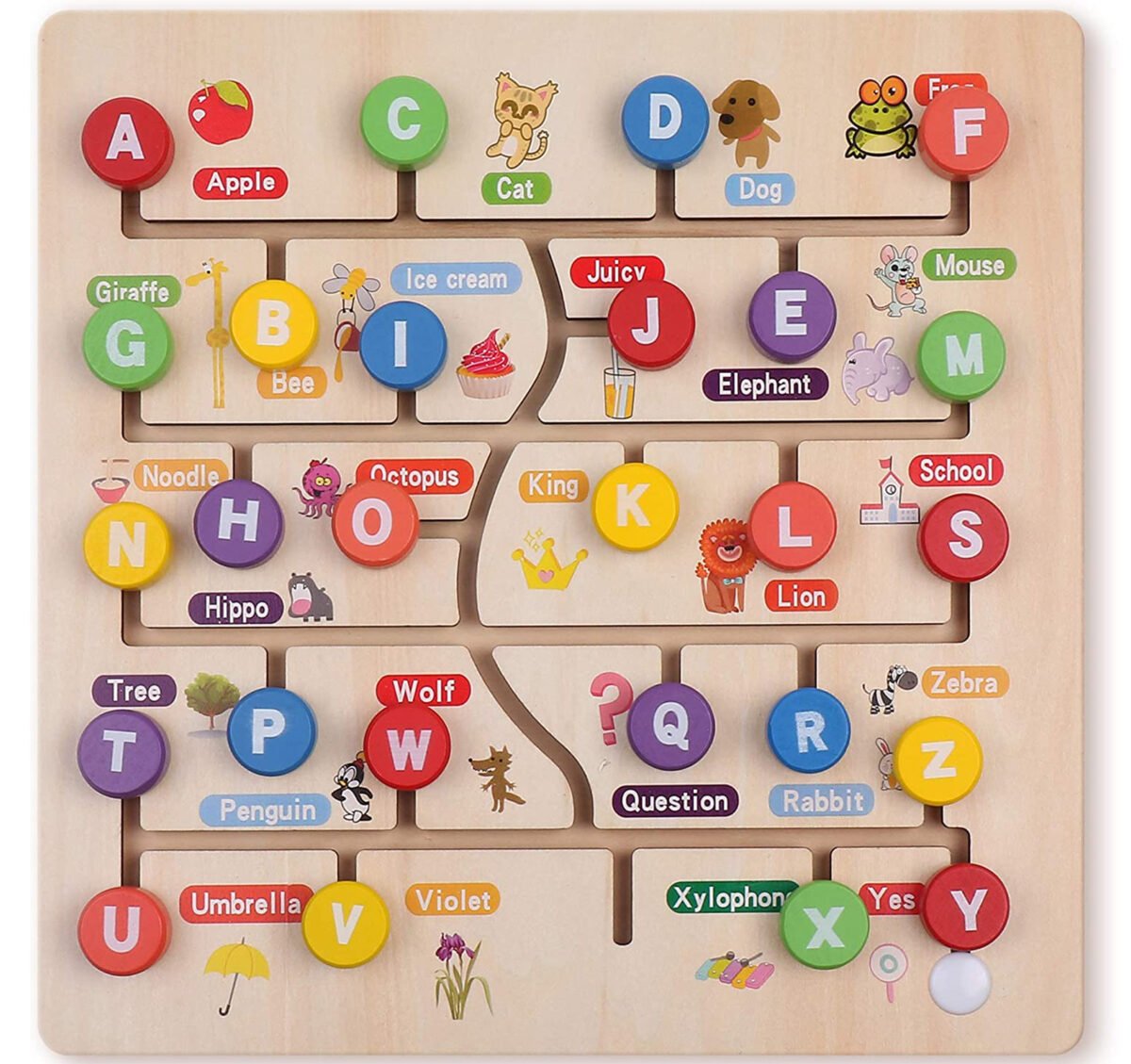
★★★☆☆
For Families | Age 3-5 | 2-3 Players
Alphabet Puzzle Tracing Board Game is nice with 3-5 years olds.
is nice with 3-5 years olds.
The square plywood board measures 11.42″ (29cm). The set includes 26 upper-case alphabet letters in colorful cute shapes.
It is safe for toddlers as the surface and edges are smooth. The pieces cannot leave the board, so you can’t lose them. Children can learn letters and associate them with words that start with the letter, introducing them to their sounds.
As it is a maze, children also have to solve the (simple) problem of moving the pieces to the correct location.
I recommend this game at home as a quiz for toddlers – a toy that lets them discover things on their own.
5 Alphabet Board Games with Cards for Pre-Kindergarten Children
Match it! Alphabet Memory (The Learning Journey)
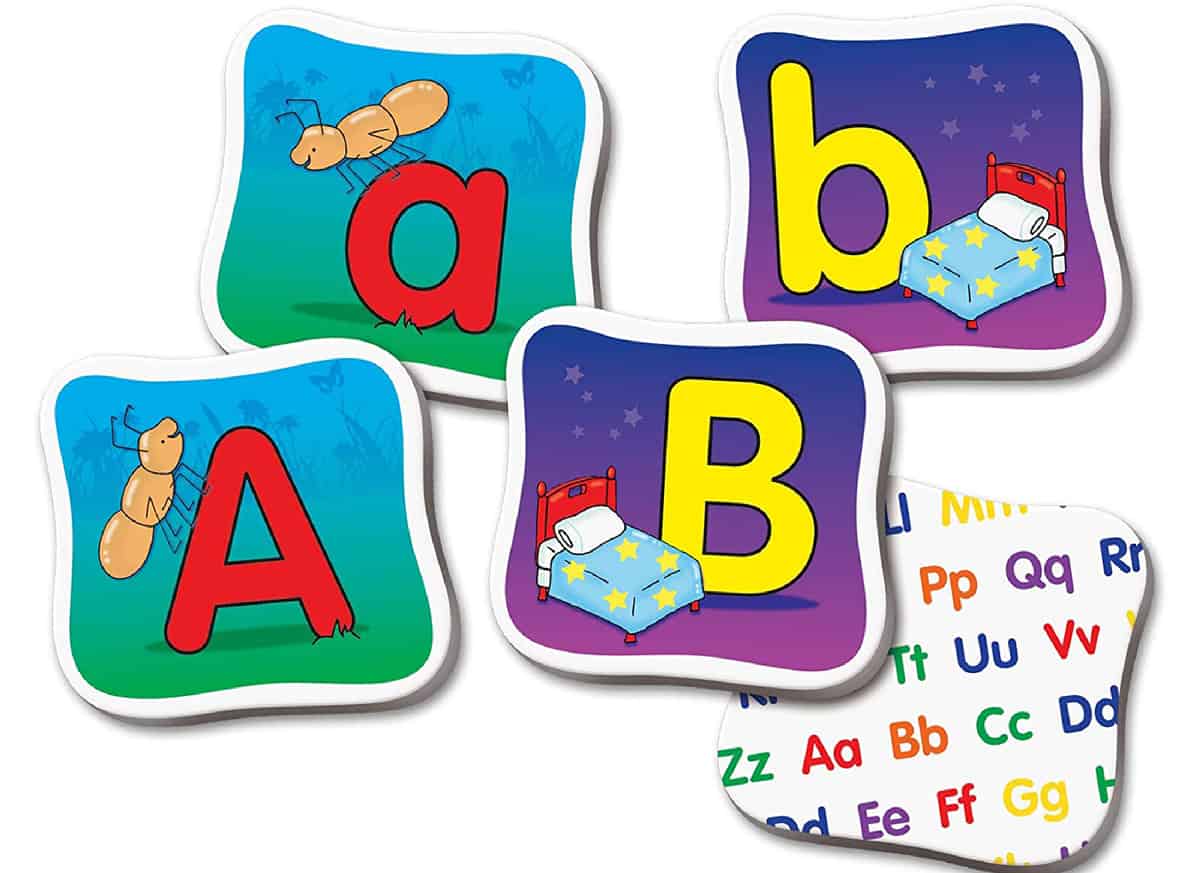
★★★★☆
For Teachers and Families | Age 3-5 | 2-4 Players
Match it! Alphabet Memory contains 52 letter tiles (Uppercase and lowercase letters), each featuring a word starting with this letter. Children can learn to recognize letters (uppercase & lowercase) as well as their most common sounds.
contains 52 letter tiles (Uppercase and lowercase letters), each featuring a word starting with this letter. Children can learn to recognize letters (uppercase & lowercase) as well as their most common sounds.
These thick and large tiles can be used by teachers as visual aids in the classroom.
The illustrations are colorful. One little problem: K is a Kitten (children associate the illustration with a cat rather than a Kitten, not a big deal as both have the same pronunciation).
Pop for Letters (Learning Resources)
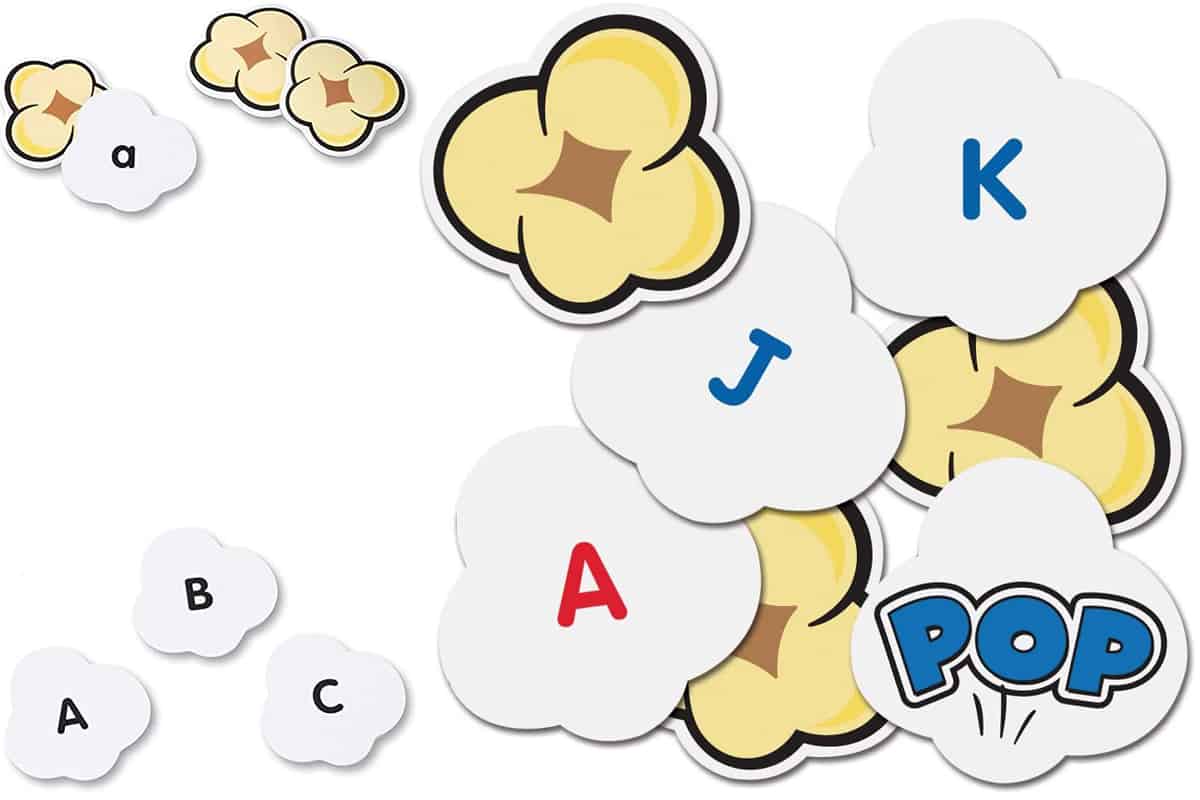
★★★★☆
For Families | Age 3-5 | 2-4 Players
Pop for Letters is a fun box set composed of:
is a fun box set composed of:
- 92 popcorn shaped letter tiles (uppercase and lowercase letters)
- 8 popcorn tiles
Small children love the popcorn shaped cards, which makes it easier to devise letter learning activities with them, even if you do not really follow the rules of the game.
By the way, I advise not to follow the rules (most of the time), because at the age children start to learn their letters (3- or 4-year-olds), they are not really ready for real “game” rules. For example, you want them to always win the cards they recognize correctly.
You can use the cards for several purposes:
- Learning to recognize letters. You can put 5 cards faces up and tell a letter (for example “D”), and the child must find which card it is to win it.
- Matching uppercase with lowercase. You can do some simplified version of memory, for example turning an uppercase card face up, and looking for the corresponding lowercase letter (the lowercase letters are faces up)
- Naming the letters: pick a card, and if the child can say aloud which letter it is, he/she wins the card
You can associate a fun thing to do to the popcorn card when it is drawn, like for example running around where you are playing once, yelling something funny, raising hands, etc…
You could even with 5–6-year-olds use the letters to form CVC words and practice simple vocabulary (this is really stretching the use of the game and I would not recommend learning CVC words that way of course) while having first exposure to spelling.
So I really recommend Pop for Letters which is a really fun way to help pre-kindergarten children learn to identify letters and know their names.
Goodie Games ABC Cookies (Learning Resources)
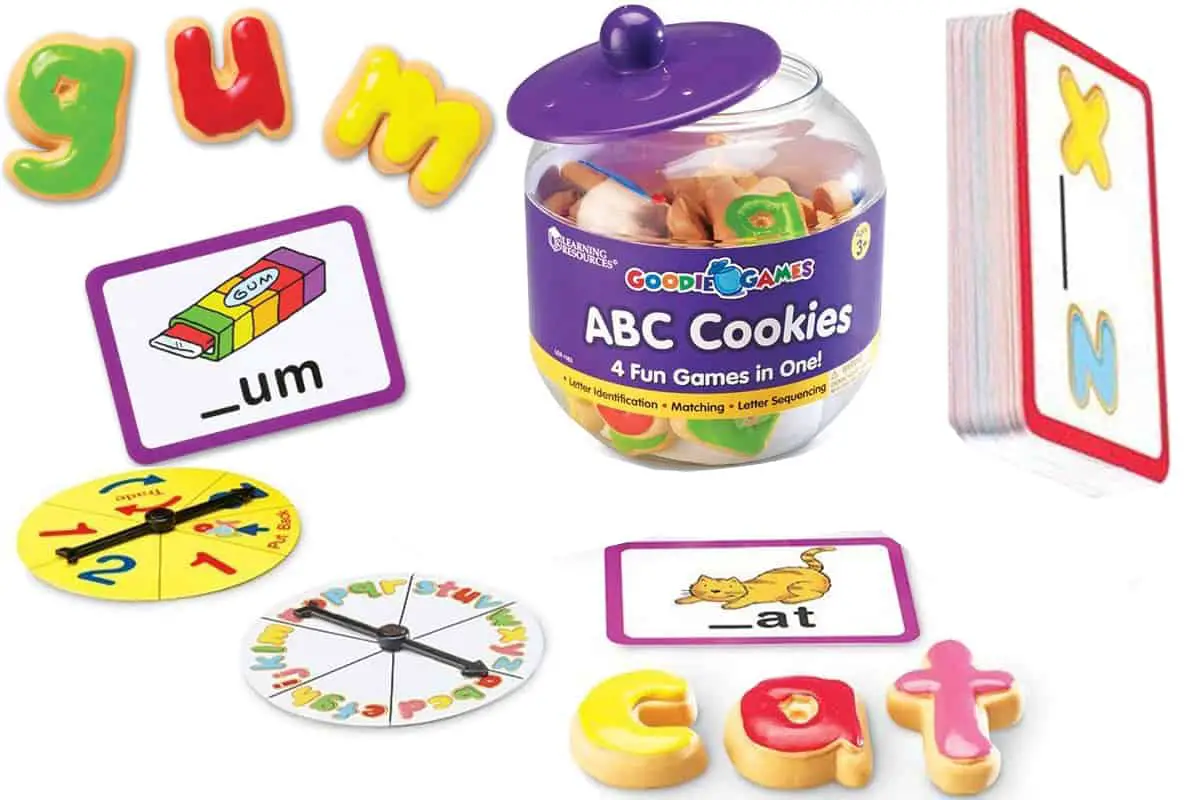
★★★☆☆
For Teachers, Therapists and Families | Age 3-5 | 2-4 Players
Goodie Games ABC Cookies has 42 plastic letter-shaped cookies (very sturdy), 45 double-sided laminated game cards, 2 spinners, a game guide and a plastic jar.
has 42 plastic letter-shaped cookies (very sturdy), 45 double-sided laminated game cards, 2 spinners, a game guide and a plastic jar.
This game can be used by families, teachers, and therapists as a generic material for:
- Letter recognition
- Recognition of beginning sounds
- CVC word building
The provided rules are extremely basic (I recommend that you create your own rules to make the game more interesting):
- Race to find letter-shaped cookies that match your cards
- Find the letter indicated on the spinner
- Use the spinner to get the cookie that matches the missing letter on the card
- Match the beginning sounds with pictures
- On a card featuring a word with a missing letter, pick a letter-shaped cookie from the jar and match it with the card to try to create a word.
- On a card with two alphabet letters and a blank, guess the missing letter by finding the correct letter-shaped cookie from the jar
There are some downsides:
- Only lowercase letters are provided
- Not all the alphabet letters are provided on the cards with one letter
- The jar is not a good packaging (cards mixed with the plastic letters, lid falls..)
But despite these problems, Goodie Games Cookies is attractive for 3- to 4-year-olds (or even 5) because the cookies are really appealing to them and of good quality.
SWAT Game (Tagitary)
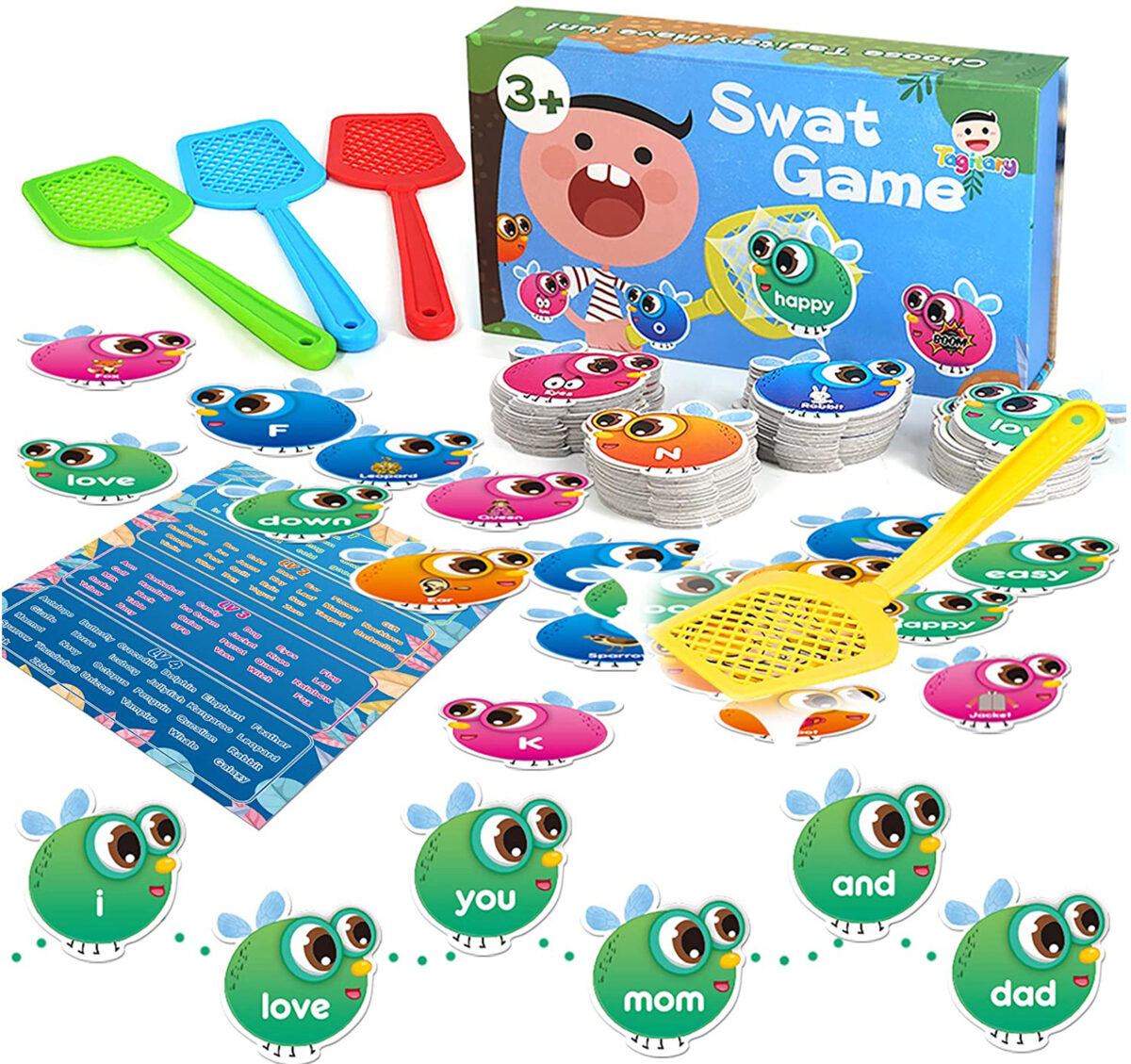
★★★☆☆
For Families | Age 3-6 | 2-4 Players
This physical game includes:
includes:
- 108 fly cards in 4 levels (uppercase letters for level 1, and 3 levels of sight words)
- 4 blank flies to add some words to the game
- 4 swatters
- 4 level cards
This swat game can be used not only to learn the alphabet but also the included sight words, which is helpful for early reading.
Of course, this is for home (at school the game would be too noisy and competitive).
To play this game, the adult reads the word (or the letter) aloud and the players try to splat it with their fly swatter. Children love the splatting part so increasing the speed makes the game more enjoyable.
Spread the fly cards across the floor to make it more challenging. Encourage the players to repeat the word as they splat the fly card.
I recommend this game to 3–6-year-old children since you can adjust the difficulty of the gameplay. You can separate the fly cards with letters only from fly cards with words and mix them up as the child improves.
Splash! Jr. Alphabet Game (Lakeshore Learning)
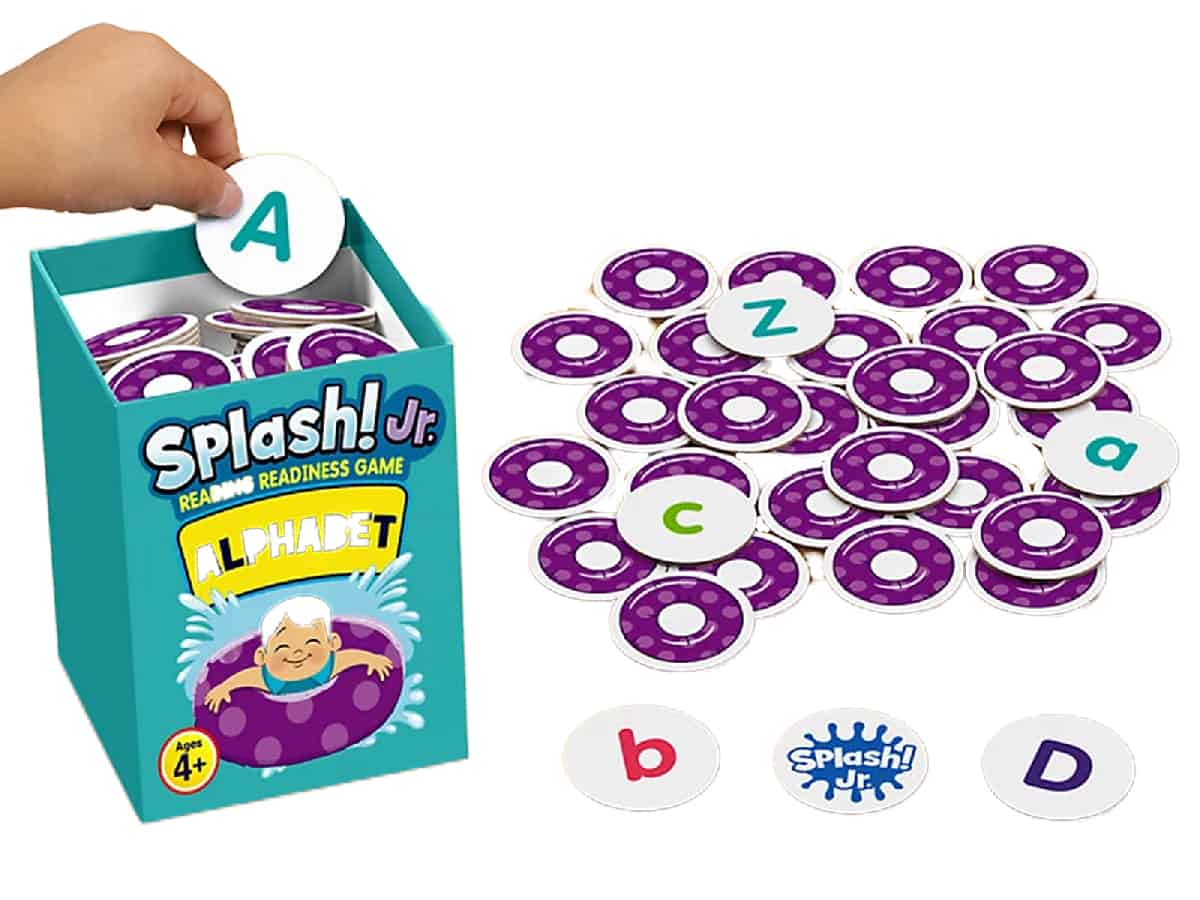
★★★☆☆
For Families | Age 3-5 | 2-4 Players
Splash! Jr. Alphabet Game helps kids master the uppercase and lowercase letters by using 80 pool-themed cards.
helps kids master the uppercase and lowercase letters by using 80 pool-themed cards.
To play this game with 2-4 players,
- Place the cards in a huge box.
- Each player must pull out a card and identify the letter on it. If it is correct, the player can keep the card. If not, the player returns the card to the box.
- If they draw the Splash! card, the game will start over.
- The first player to collect 10 cards straight wins the game! (You can speed up the game by lowering the target to 5 cards)
Getting the Splash! card can be frustrating for pre-kindergarten children so modify the rules or remove it from the game.
I recommend this game to 3–5-year-old children because it is easy to play and memorize the alphabet.
6 Alphabet Toys for Pre-kindergarten Children
These Alphabet toys are attractive to children because they feature funny and cute objects like alligators, dinosaurs, eggs and more.
Alphabet Acorns (Learning Resources)
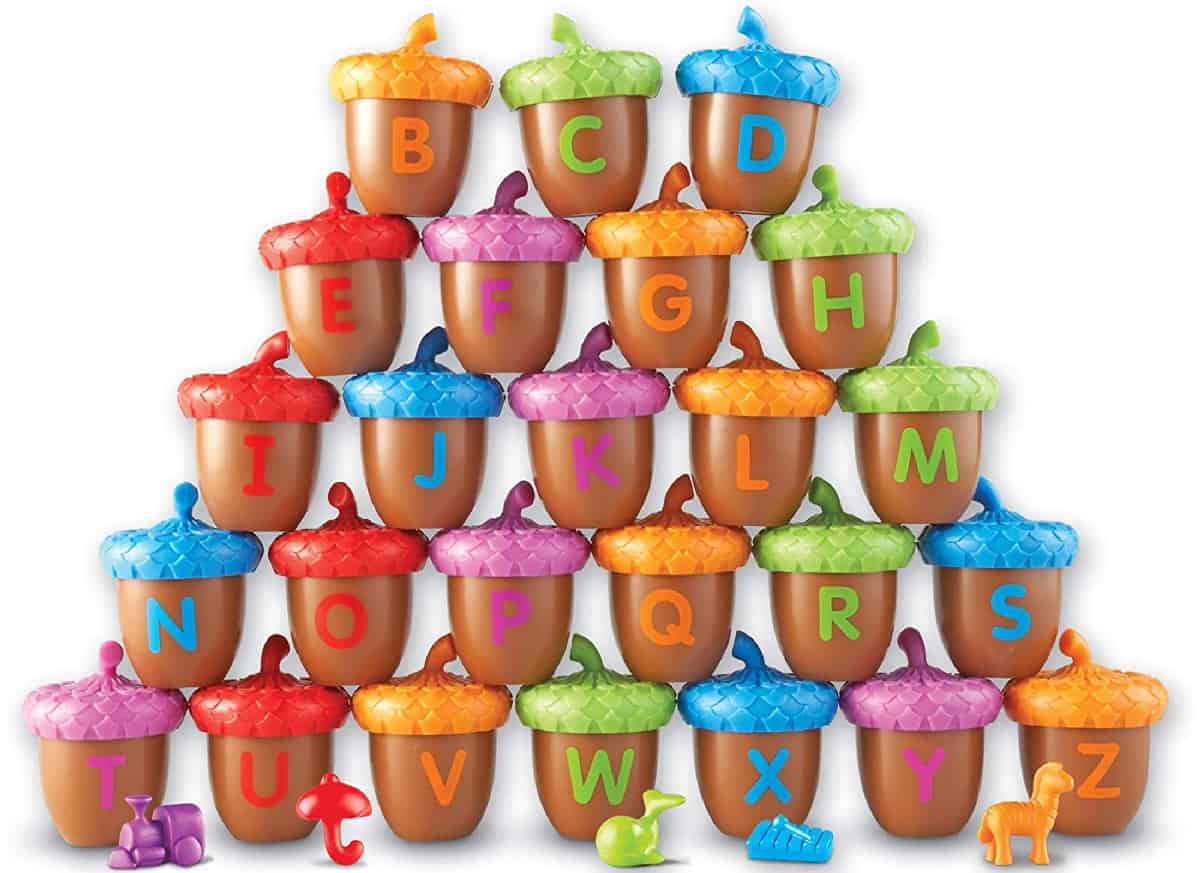
★★★☆☆
For Teachers and Families | Age 3-5 | 2-4 Players
Alphabet Acorns activity set includes 26 two-piece acorns and 26 color-coded counter figures.
activity set includes 26 two-piece acorns and 26 color-coded counter figures.
The uppercase letters are printed on the acorns while the lowercase letters can be found inside its matching colorful tops.
There are six suggested activities from the game guide but I chose one of them that is helpful for alphabet recognition.
Alphabet Cleanup
- Let the child open the acorn and take the objects out.
- Mix the objects and spread them out on the floor or à table.
- Ask the child to match the objects through its beginning letter to the letter on the acorn.
- Tell the child to put the objects back to the acorn if the object and the letter were matched successfully.
Although this toy can be used to teach the beginning sounds, it is not totally accurate for this purpose. Some miniatures do not represent the most frequent sound of the beginning letter. For example, the miniature for U is an umbrella. Umbrella starts with the sound “Uhm” not “you”.
Overall, I recommend this toy for 3–5-year-old children because the small objects inside the acorns are entertaining to play with. They help children learn the alphabet fast.
Alphabet Dinosaurs (Boley)
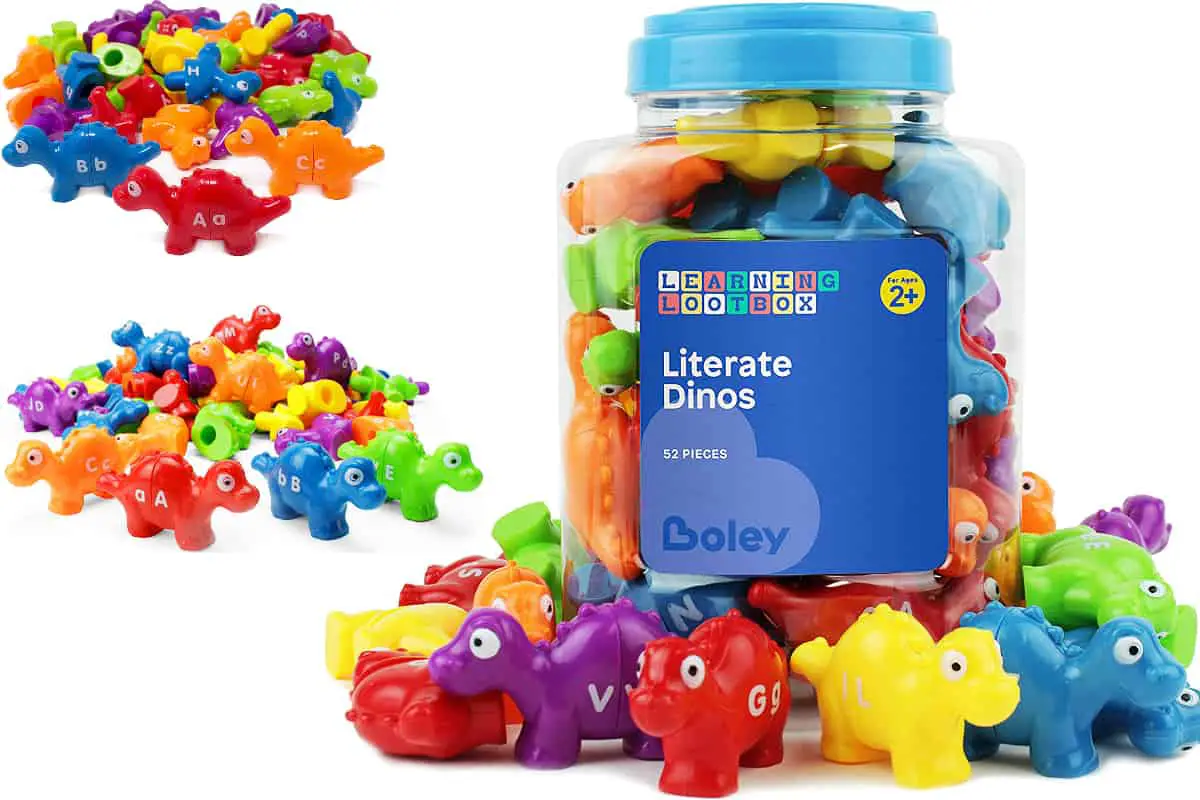
★★★☆☆
For Families | Age 3-4 | 1-4 Players
Alphabet Dinosaurs includes a plastic jar and 26 dinosaur alphabet figures that can be split apart into big and small letters.
includes a plastic jar and 26 dinosaur alphabet figures that can be split apart into big and small letters.
This puzzle toy is similar but better than Smart Snacks Alpha Pops because the set is complete. That means
because the set is complete. That means
- The letters are on one side
- They can line up the dinosaurs in alphabetical order
Both toys are not self-correcting so adults should guide the toddlers in getting the correct pair because any head fits with any tail.
This toy helps 3–4-year-old children practice letter identification.
Smart Snacks Alpha Pops (Learning Resources)
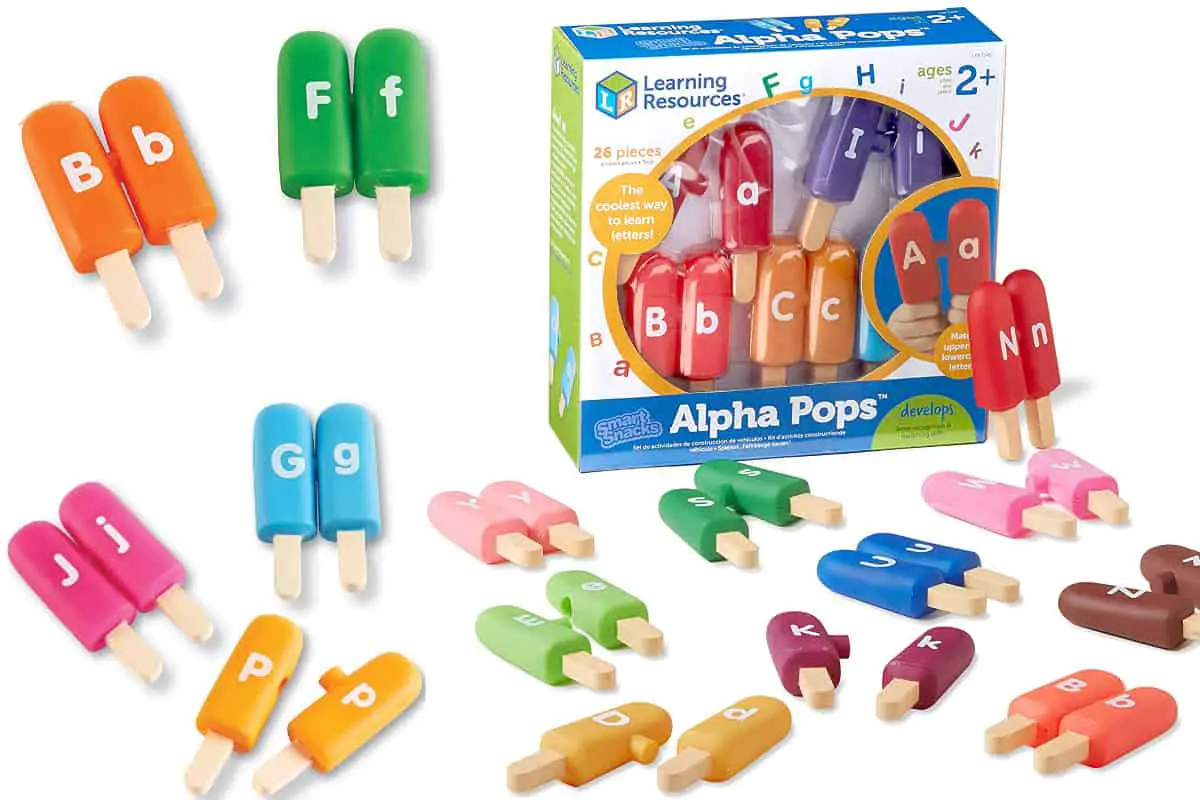
★★★☆☆
For Families | Age 3-4 | 2-4 Players
Smart Snacks Alpha Pops has 26-double sided color-coded pops (there is a diffrent letter on each side).
has 26-double sided color-coded pops (there is a diffrent letter on each side).
The main objective of the toy is to match the uppercase letters to lowercase letters. Toddlers enjoy it because it involves putting popsicles together and pulling them apart.
Just a reminder, lining up the letters in alphabetical order is possible up to 13 letters only (A-M or N-Z) since the remaining letters are on the other side.
All in all, I recommend this toy as a learning tool for 3–4-year-old children because it focuses on letter recognition.
Matching Eggs (Coogam)
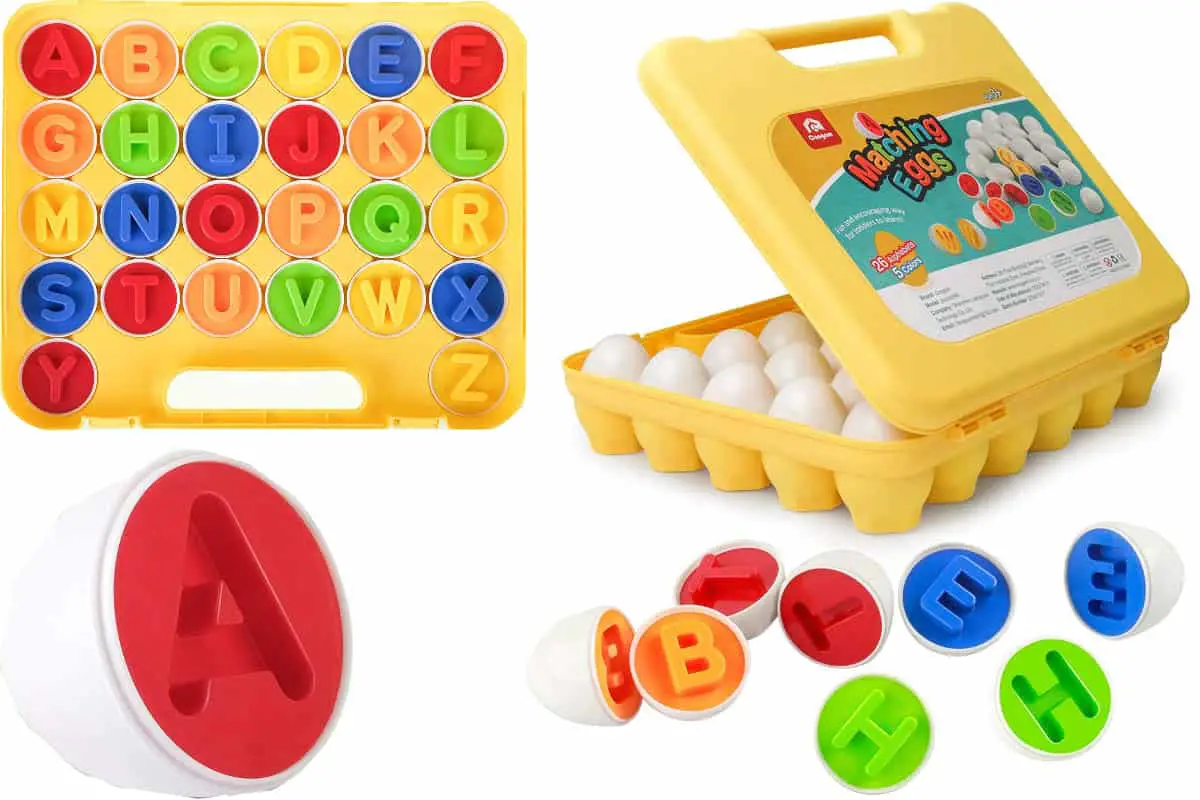
★★★☆☆
For Families | Age 3-4 | 2-4 players
Matching Eggs comes with a tray filled with 26 white eggs.
comes with a tray filled with 26 white eggs.
The interior of the white eggs or the “yolk” is embossed with 26 color-coded uppercase letters.
Although this toy features uppercase letters only, toddlers will enjoy learning the alphabet because the egg pieces are movable and stimulating. They can play with it in different ways.
Matching Eggs (Revvit)
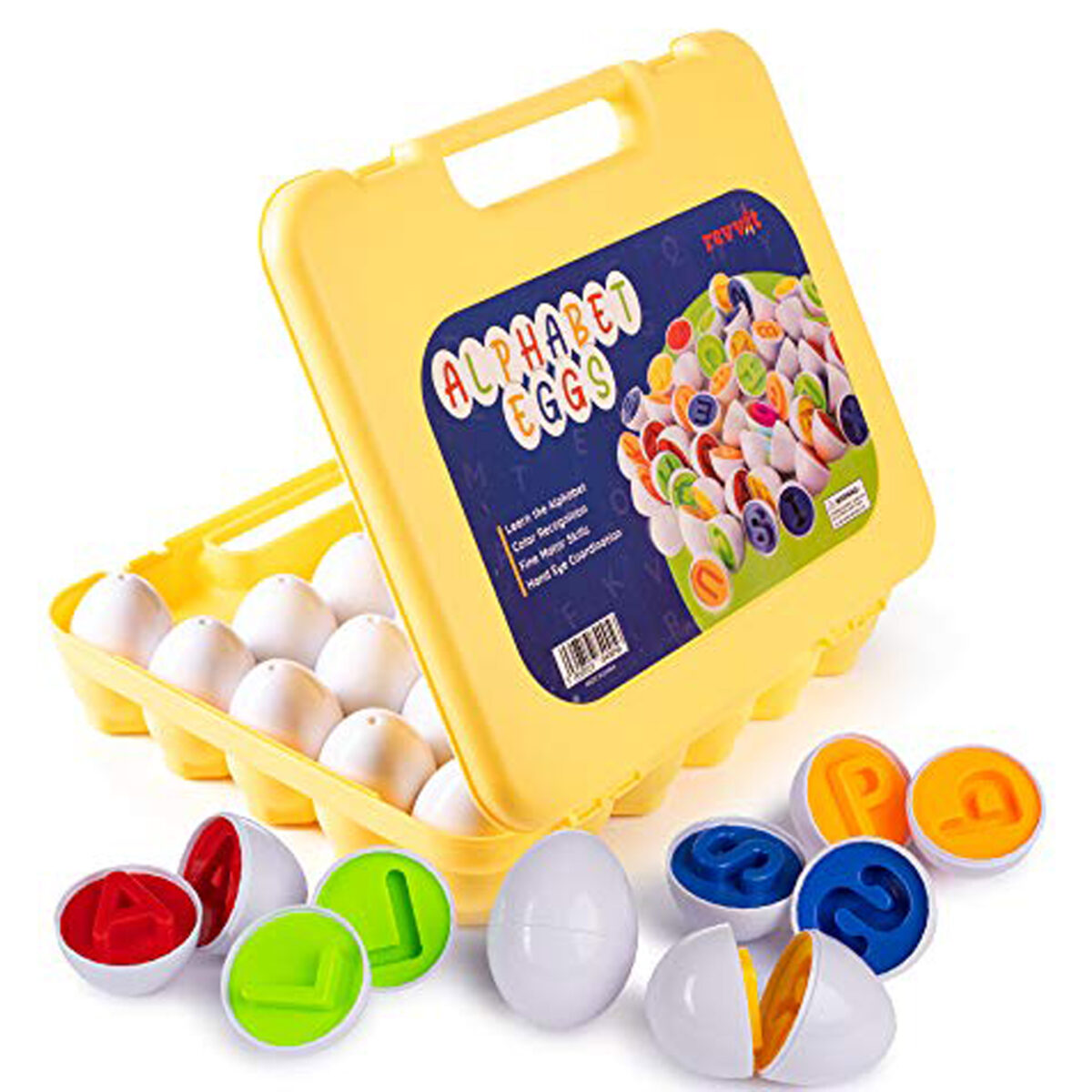
★★★☆☆
For Families | Age 3-4 | 2-4 Players
Matching Eggs is a matching game similar to Matching Eggs (Coogam)
is a matching game similar to Matching Eggs (Coogam) . It has 26 white eggs that have colorful interiors and a portable case.
. It has 26 white eggs that have colorful interiors and a portable case.
Just like the previous toy, this one can help children learn the alphabet in uppercase letters only.
Overall, I prefer to introduce this game to toddlers at home because they can play with it as long as they want. All they need to do is crack the egg open, mix them up then match the letters and the colors inside.
Snap-n-Learn Alphabet Alligators (Learning Resources)
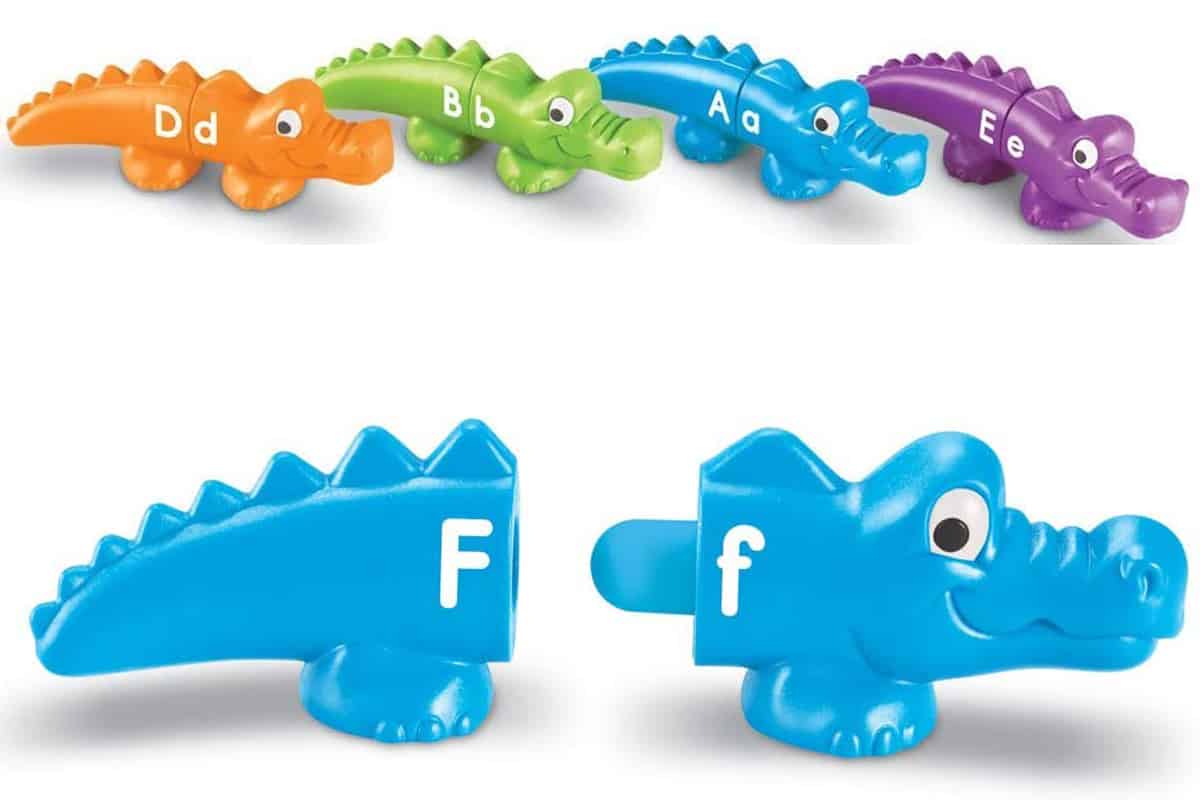
★★☆☆☆
For Families | Age 3-4 | 2
Snap-n-Learn Alphabet Alligators set includes 13 sturdy plastic heads and 13 tails of alligators. Each was marked with the letters of the alphabet in big and small letters.
set includes 13 sturdy plastic heads and 13 tails of alligators. Each was marked with the letters of the alphabet in big and small letters.
This matching game is similar to Smart Snacks Alpha Pops and Alphabet Dinosaurs
and Alphabet Dinosaurs . It can be used to introduce the 13 letters of the alphabet.
. It can be used to introduce the 13 letters of the alphabet.
There are two ways to play this toy:
- Match the small letters on tails to big letters on alligator heads.
- Match the color of the alligator heads to the alligator tails.
I recommend this toy to toddlers because they are amused with alligators. They play it by snapping the pieces apart or snapping them together.
However, learning the entire alphabet is not possible since not all letters are available.
2 Alphabet Memory-Matching Toys for Pre-Kindergarten Children
Last but not least, I would like to share two educational toys that can be played at home in several ways.
ABC Learning Lock (Dinhon)

★★★☆☆
For Families | Age 3-5 | 2-4 Players
ABC Learning Lock set includes 26 locks and 26 keys.
set includes 26 locks and 26 keys.
The locks carry the uppercase letters while the keys have the lowercase letters. The locks have cute illustrations at the back of the letter. The image represents the beginning sound of the letter.
The main objective of the game is to match the lowercase keys to its corresponding uppercase locks. The lock opens if the child inserts the correct key.
This game is good for learning letters and the most common sound for each letter.
Pre-kindergarten children can enjoy the toy competitively or cooperatively. For instance, I recommend them to play it
- Alone so that they can learn by trial and error
- With two players: one looks for the key, the other one tries to open the lock
- With 2-4 players (distribute the locks equally then let them find the keys together)
ABC Learning Lock (IQ Toys)
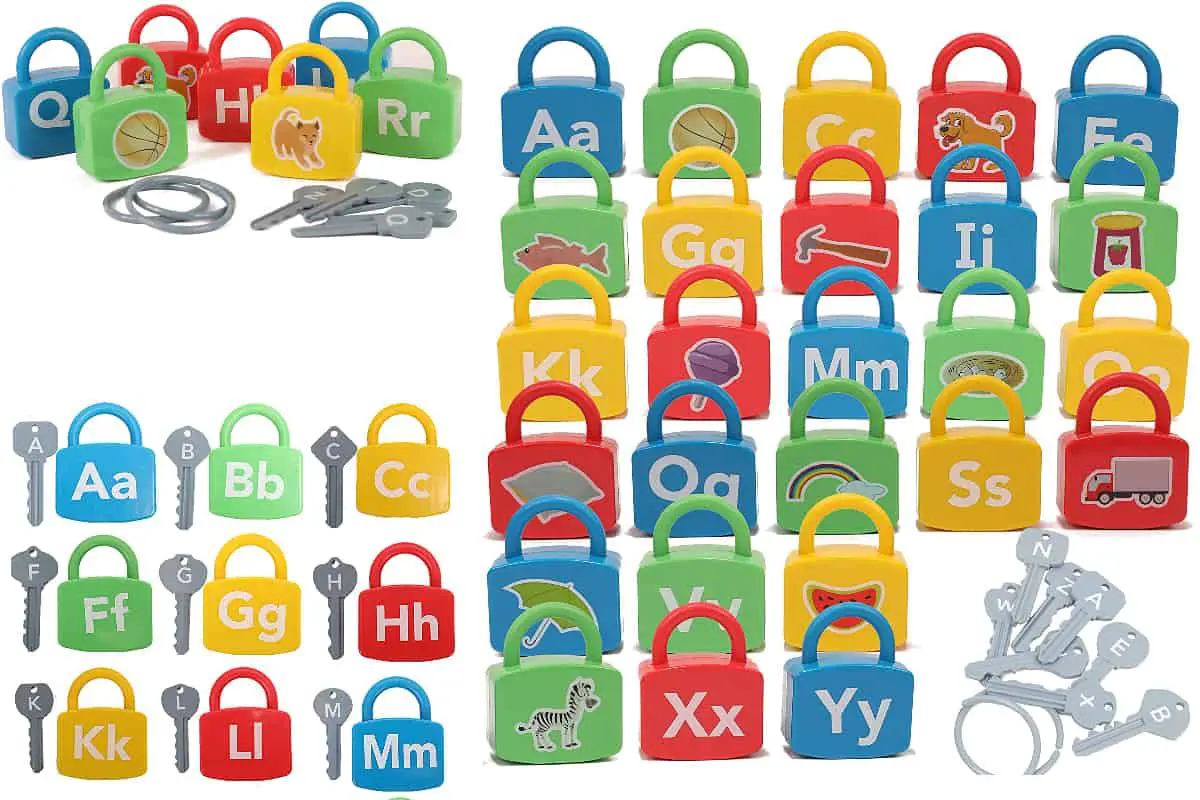
★★★★☆
For Families | Age 3-5 | 2-4 Players
ABC Learning Lock from IQ Toys is similar to ABC Learning Lock
from IQ Toys is similar to ABC Learning Lock made by Dinhon. It has 26 locks, 26 keys and 4 rings.
made by Dinhon. It has 26 locks, 26 keys and 4 rings.
Their main difference is that the locks in this game display both uppercase and lowercase letters in front and a cute image at the back of the lock. The keys carry uppercase letters in front and lowercase letters at the back.
Therefore, 3–4-year-old children can compare the letters and memorize the letter pair easily.
In this game, players can:
- Match the letter on the keys to the letters on the locks.
- Match the sound of the letter on the key to the images on the locks.
Adults need to watch out for instances that children cannot unlock the locks, or the keys do not fit the locks as this may cause frustration on them.
This educational toy can be used even without using the keys. For instance, they can :
- ask the 4–5-year-old child to line up the locks in alphabetical order (then remove some letters to be identified by the child)
- identify the image on the lock to increase vocabulary
Child’s Typical Progress
Here is a short reminder of a child’s typical progress. This will hopefully help you choose the right game for your children:
- By age 2, they identify some letters and sing aloud the “ABC” song.
- By age 3, they remember part of the alphabet and start to connect letters to sounds.
- By age 4, they recite the alphabet in the correct order.
- Entering kindergarten, most children can match letters to their most frequent sounds, and uppercase and lowercase versions of some letters
Other Types of Games to Learn the Alphabet
Children love playing alphabet fishing games as well. You might want to check my post “13 Magnetic Alphabet Fishing Games for 2- to 5-year-olds “.
“.
Your child can also learn phonemic awareness and improve sound discrimination by playing rhyme dice games .
.
Edudingo.com is a participant in the Amazon Services LLC Associates Program, an affiliate advertising program designed to provide a means for sites to earn advertising fees by advertising and linking to Amazon.com. We also participate in other affiliate programs which compensate us for referring traffic.

